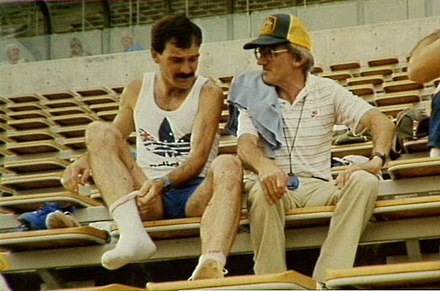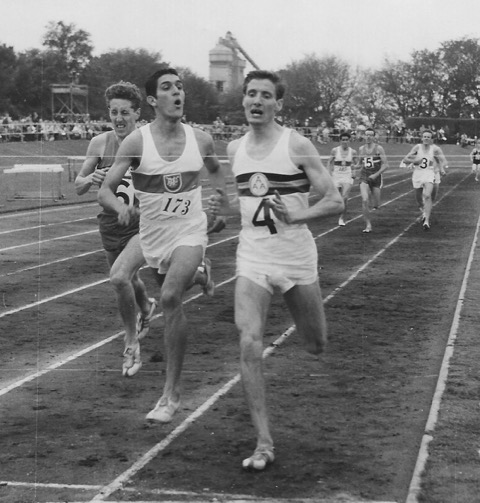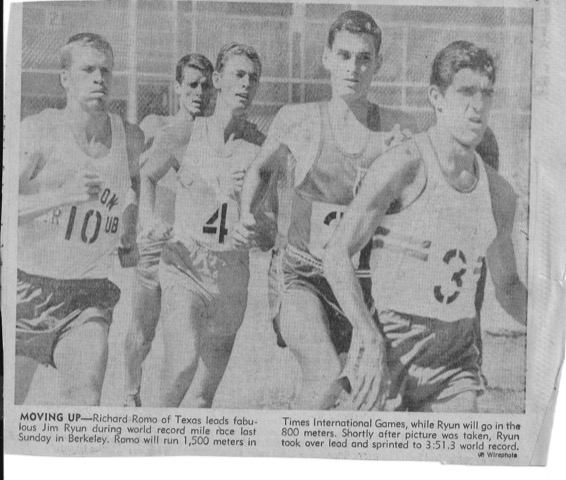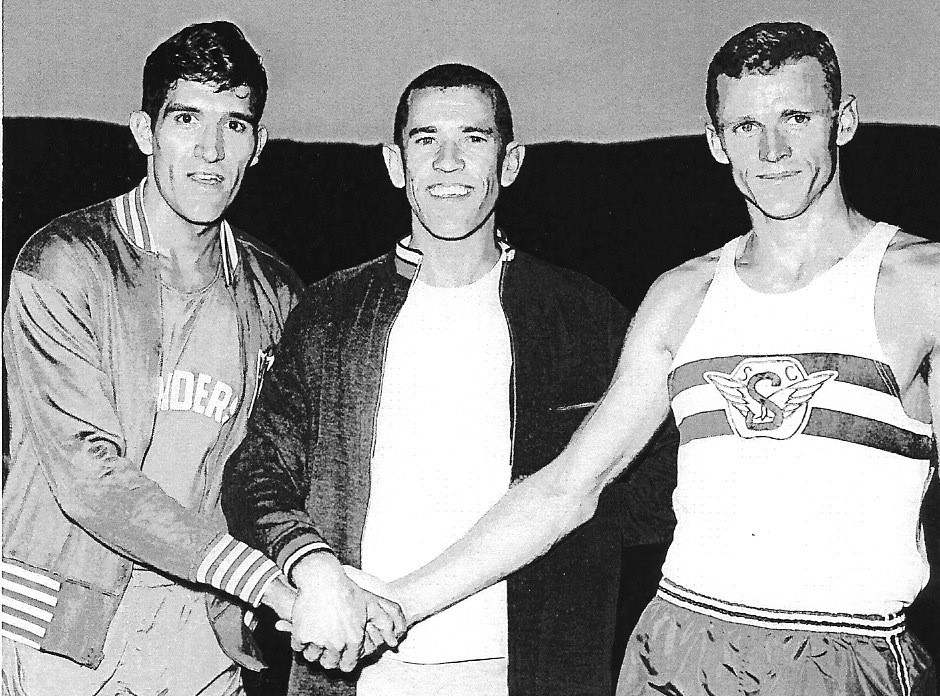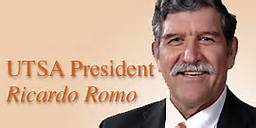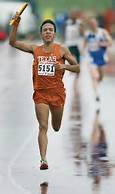Ricardo Romo’s Longhorn and Beyond story by Billy Dale
Breaking the 4-minute mile was a mental challenge more than a physical one. After Bannister broke the 4- minute mile, many more followed, including Longhorn Ricardo Romo. Why did the number of 4-minute milers grow exponentially after Bannister's accomplishment? "Was there a sudden growth spurt in human evolution? Was there a genetic engineering experiment that created a new race of super runners?
No. What changed was the mental model. The past runners had been held back by a mindset that said they could not surpass the four-minute mile. When that limit was broken, others saw that they could do something they had previously thought impossible.
Ricardo Romo is a perfect icon to represent the qualities of breaking through mental obstacles. He was an innovator, a change agent, and an ideal hero for defining success. But, as it turns out, when he broke through a previously impenetrable track-and-field barrier, he taught us what it takes to break new ground.
Like all of us, Ricardo's growth curve was not in a straight line. Peaks and valleys are part of his life journey, but at his core, he has always been an innovator willing to change a game plan. One who transitioned old-school thought to contemporary progressive winning strategies. A Leader driven to accomplish things that have not been done before.
Ricardo showed everyone by example to not accept limitations, tradeoffs, and middle-of-the-road sensibilities that define conventional wisdom.
Memories of a Sub-Four Minute Miler By Ricardo Romo
July 30, 2019
Today, fifty-three years ago--almost to the day-- I became the first Texan to run a mile under four minutes. What I didn’t know at the time was that only 18 Americans had ever accomplished that feat. I have been asked many times about writing about that achievement, and up to now, I had not given it much thought. Then I realized that I spent thousands of hours training to excel in the event that took me less than four minutes to complete. Was it worth such an expenditure of time and effort? And would I recommend others to try it? Yes-- here is my story.
In 1960, at age 16, (when everyone called me Richard) I finished 5th in the state track competition with a 4:30 mile time, a respectable time for a 10th grader. By my senior year in high school I had improved my time significantly. My 4:10 mile was one of the fastest ever by a U.S. high school runner.
Three state championships earned me a track scholarship at the University of Texas Austin. UT Austin had great academic programs and one of the finest track programs in the nation. I started college with three goals: To run a sub-four minute mile; to graduate from The University of Texas; and to earn All-American honors in Track and Field.
At UT Austin I was fortunate to have Pat Clohessy, a former runner at the University of Houston and U.S. champion in the 5,000 meters. Clohessy came to UT to earn his Masters’ degree and was offered a graduate assistant position in the track program. He served as my distance coach and mentor. Clohessy trained with us daily throughout my freshman and sophomore year and his mentoring paid off. In the summer of 1963 I improved my mile time to 4:05 in a track meet in Wales, British Isles. I came in second but defeated two of England’s top Olympic runners. It was the fastest mile time for a freshman in the United States. I was on my way.
A serious track injury in an indoor track meet in Fort Worth in February of 1965 nearly ruined my track ambitions. As I started the 1,000 yard run, I felt a sharp pain in my left ankle. We were running indoors on a dirt track and thus everyone used regular long spikes. A spike from the runner behind me caught my ankle and served my tendon. I felt the pain, but since I was in the lead, I decided to finish the race.
I crossed the finish line in first place, but I left blood dripping from the back of my shirt. It was a serious injury and it required three months to cure the infection in my leg related to the dirt field. My surgery went well and after four months I resumed my training--albeit quite slowly. I was not certain if the injury would hamper my full development as a primer runner. By December I was back in top shape. I had lost the 1965 track season, but felt lucky to be competing again.
My preparation for a sub-four minute mile required superb conditioning and being at the right track meet at the right time. I was living in Texas, but in the 1960’s our state shut down most of its competitive track meets over the summer. Everyone agreed that California offered the best opportunity for competitive meets on a weekly basis and possibilities for fast times.
In the summer of 1966, I spent the summer in California with the expressed goal of running a sub-four minute mile. Two friends made the transition to running in California possible for me. First, Gene Comroe, a UCLA trackman who hailed from Dallas and competed in the same Texas state and regional high school meets with me assisted by providing a spare bedroom for me over that summer. Comroe was a member of the Southern California Striders, a track club that included the UCLA middle distance star, Bob Day. Day was a sub-four minute miler and a world class runner at 800 meters.
Comroe and Day introduced me to Atis “Pete” Peterson, the Striders’ distance coach. Peterson’s famous motto was “Run for Fun,” and many of our workouts over the summer of 1966 were exactly that. Peterson trained Bob Day and Ted Nelson, a former Canadian middle distance star and the American indoor record holder for 1,000 yards. Not long after meeting Nelson, he and I both decided that we would add extra speed training to our practice to prepare us for a sub-four minute mile.
Two events prepared me personally for my sub-four minute mile in 1966. While it has been more than 50 years ago, I remember the events quite clearly. In June of 1966 I competed in the San Monica Invitational meet which featured Cary Weisiger, a former Duke star miler with a best time of 3:56.6. I ran well that day and beat Weisiger by more than ten yards. I knew then that my training was paying off.
On July 17, 1966 I had my second opportunity to assess my readiness for a sub-four minute mile. I had been invited to the Berkeley Invitational where I learned that Jim Ryun would attempt to break the world record of 3:53.6 set by Michel Jazy in 1965. I had competed against Jim Ryun numerous times, defeating him once in May of 1964. Two months later, he improved his time and finished third in the U.S. Olympic trials, which earned him a trip to the Olympics in Tokyo.
Ryun’s plans were to run a 3:52 mile or better. To do so, he wanted a 58.0 first quarter. Tom Von Ruden delivered with a 57.7 quarter. I took over with a goal of running a 1:56 first half. I felt comfortable and got to the half-mile in 1:55.5. It was a bit fast, but the first quarter had also been fast. I remember that the crowd started cheering when the halftime was announced. They knew that Ryun had a shot at a 3:50 mile.

Wade Bell took over from me and led Ryun to 2:55.3 at the third quarter, definitely on world record pace. Ryun always had a great kick and everyone expected that he would run 57 flat or better in the last quarter. He did indeed and his 55.0 seconds last quarter brought him to the finish line at a world record 3:51.3. Ryun had broken the world record by more than two seconds, a highly improbable feat.
I was exhausted at the three-quarters mark but decided to hang on, and, as a consequence, I finished third in the race. I learned soon that I had managed a highly respectable time of 4:01.4, one of my fastest times ever. Weisiger, who paced himself carefully, finished second with a 3:58.0 effort. It occurred to me minutes after finishing that if Weisiger, whom I had beaten two weeks earlier, could run a 3:58 mile, so could I.
Great distance runners build up their endurance and speed over many years. Every world record holder has done it differently. Roger Bannister trained religiously but did so while studying for a medical career. Herb Elliott trained three or more times a day and seemed to live only for setting world records. When Ryun set the world record, he was a 20-year-old college student and the youngest to be a world record holder in the middle distance.
After the Berkeley mile, I returned to Los Angeles to continue my training. Bob Day, a 3:56 miler, often joined me and other runners for afternoon and weekend runs. Pete Peterson thought I was ready for a sub-four effort and selected an invitational meet in the San Fernando Valley for me to compete in August.
Ricardo Romo from dishwasher, to Longhorn sub- 4 miler to President of the University of Texas San Antonio.
On the day of the race, I took the day off from my job at the Century Plaza Hotel. To pay my bills I was busing dishes and washing drink glasses. That summer the job market was tight and I felt lucky to find work that did not interfere with my training. I rested all day and left two hours early for the track meet.
Ted Nelson and I agreed that we would push each other to run an even pace of 60 seconds per quarter. We were both excellent kickers and felt confident that we could finish the last quarter under 60 seconds. All went as planned. We were dead even with 300 yards to go when I began to accelerate. My time of 3:58.8 was more than I had expected. Nelson finished ten yards back with an excellent 3:59.5 effort.
Important and memorable accomplishments are often done with the help of others--in some cases, many individuals. Over many years, I trained with other teammates and received excellent advice on how to prepare. I quickly learned that distance running also requires discipline, and over the years, I learned to push myself while setting reasonable expectations.
For me, all that training paid off on a cool August evening when I became the 19th American to run a sub-four mile. While I thought I might have run faster, I was humbled to know that my 3:58.8 was the 7th fastest ever by an American and surpassed the best of any Texas or South American runner. My friends often remind me that my mile time also made me the first Texan and first Hispanic to run a sub-four-minute mile.
My record stood for 40 years, and I was pleased that when it was broken, it was by a fine UT Longhorn runner by the name of Leonel Manzano.
Manzano broke my record by less than two seconds but went on that year to win a silver medal in the Olympics.
MOVING ON FROM TRACK TO A HIGHER EDUCATION
Ricardo chose Texas for his education. After receiving his Bachelor’s degree from Texas, he attended Loyola Marymount University to obtain his Master’s in history. Later, Romo obtained his Ph.D. in history from UCLA, officially becoming Dr. Romo. In 1980, Dr. Romo returned to Austin, where he accepted a position as a professor of history at the University of Texas. He would later become Vice Provost for undergraduate education. He also directed the Texas office of the Tomas Rivera Center from 1987 to 1993. In May of 1999, Dr. Romo was honored as the fifth President of the University of Texas at San Antonio. UTSA flourished under his leadership.


